Analysis of a New Super High Temperature Hybrid Absorption-Compression Heat Pump Cycle
Abstract
:1. Background
2. Principle of the Hybrid Heat Pump
2.1. Cycle Process
2.2. Mathematical Model
- (1)
- The cyclic calculation is carried out in steady states;
- (2)
- The heat loss and pressure loss of flowing during the cycle is ignored, because they are quite small and appear in parts only, such as heat exchangers, pumps, throttle valves, and compressors;
- (3)
- The enthalpy of working fluids at the inlet and outlet of the throttle valve remains constant;
- (4)
2.2.1. Mathematical Model of Units
- (1)
- Generator model
- (2)
- Condenser1-Evaporator2 model
- (3)
- Evaporator1-Condenser2 model
- (4)
- Heat exchanger
- (5)
- Compressor(1) model
- (6)
- Absorber model
- (7)
- Compressor(2) model
2.2.2. Performance model
2.3. Model Validation
3. Results and Discussion
3.1. Selection of the Working Fluid in the Compression Sub-Cycle
3.2. The Influence of Low Pressure Stage Coupling Temperature on Cycle
3.3. The Influence of High Pressure Stage Coupling Temperature on Cycle
3.4. Influence of Compressor Pressure Ratio
3.5. Optimal Condition of Hybrid Cycle
3.6. Exergy Analysis of Hybrid Cycle
4. Conclusions
- (1)
- Simulation of compression sub cycle with R142b, R134a, R1234ze, R245fa, R152a and R236fa is analyzed, and R245fa is selected, with a higher COP and lower discharging temperature;
- (2)
- The COP of the coupling cycle increases with the coupling temperature of the low pressure stage when the pressure ratio is 4 and the coupling temperature of the high-pressure stage is 95 °C; the coupling cycle COP increases with the coupling temperature of the high pressure stage when the pressure ratio is 4 and the coupling temperature of the low-pressure stage is 50 °C;
- (3)
- COP of the coupling cycle decreases with the pressure ratio, and the maximum COP is 2.785 when the pressure ratio is 1.5 when the coupling temperatures of the high-pressure stage and the low-pressure stage are 95 °C and 40 °C;
- (4)
- The optimal operating conditions when the heat source temperature is 160 °C and the heat sink temperature is 200 °C are obtained by comparing the optimal operating conditions under different pressure ratios. The COP takes the maximum value 3.249 when the pressure ratio is 6.5, the low-pressure stage coupling temperature is 55 °C and the high-pressure stage coupling temperature is 73 °C. Meanwhile, the simulation results of exergy efficiency under optimal operating conditions show that generator, absorber and compressor should be improved to enhance cycle performance.
- (5)
- The exergy efficiency of evaporation and condensation is higher due to the small temperature difference in its heat transfer process.
Author Contributions
Funding
Data Availability Statement
Conflicts of Interest
Nomenclature
| Subscripts | Abbreviations | ||
| specific heat, kJ kg−1 K−1 | COM2 | compressor2 | |
| h | specific enthalpy, kJ kg−1 | CON1 | condenser in the absorption cycle |
| m | mass flow rate, kg s−1 | CON2 | condenser in the compression cycle |
| Q | thermal energy, kW | EVA1 | evaporator in the absorption cycle |
| W | power, kW | EVA2 | evaporator in the compression cycle |
| x | concentration, % | GEN | generator |
| η | efficiency | hybrid | hybrid cycle |
| ABS | absorber | is | isentropic |
| COM | compression cycle | ref | reference |
| COM1 | compressor1 | COP | Coefficient of performance |
| EES | Engineering Equation Solver |
References
- Green, C. A ‘fair and ambitious’ climate agreement is not nearly enough: Paris 2015 take heed. Environ. Res. Lett. 2015, 10, 101003. [Google Scholar] [CrossRef]
- Zhang, J.; Zhang, H.H.; He, Y.L.; Tao, W.Q. A comprehensive review on advances and applications of industrial heat pumps based on the practices in China. Appl. Energy 2016, 178, 800–825. [Google Scholar] [CrossRef]
- Kim, J.; Park, S.R.; Baik, Y.J.; Chang, K.C.; Ra, H.S.; Kim, M.; Kim, Y. Experimental study of operating characteristics of compression/absorption high-temperature hybrid heat pump using waste heat. Renew. Energy 2013, 54, 13–19. [Google Scholar] [CrossRef]
- Hu, B.; Liu, H.; Wang, R.Z.; Li, H.B.; Zhang, Z.P.; Wang, S. A high-efficient centrifugal heat pump with industrial waste heat recovery for district heating. Appl. Therm. Eng. 2017, 125, 359–365. [Google Scholar] [CrossRef]
- Wu, D.; Hu, B.; Wang, R.Z.; Fan, H.B.; Wang, R.J. The performance comparison of high temperature heat pump among R718 and other refrigerants. Renew. Energy 2020, 154, 715–722. [Google Scholar] [CrossRef]
- Frate, G.F.; Ferrari, L.; Desideri, U. Analysis of suitability ranges of high temperature heat pump working fluids. Appl. Therm. Eng. 2019, 150, 628–640. [Google Scholar] [CrossRef]
- Mateu-Royo, C.; Navarro-Esbrí, J.; Mota-Babiloni, A.; Amat-Albuixech, M.; Moles, F. Theoretical evaluation of different high-temperature heat pump configurations for low-grade waste heat recovery. Int. J. Refrig. 2018, 90, 229–237. [Google Scholar] [CrossRef]
- Kosmadakis, G.; Arpagaus, C.; Neofytou, P.; Bertsch, S. Techno-economic analysis of high-temperature heat pumps with low-global warming potential refrigerants for upgrading waste heat up to 150 °C. Energy Convers. Manag. 2020, 226, 113488. [Google Scholar] [CrossRef]
- Markmann, B.; Tokan, T.; Loth, M.; Stegmann, J.; Hartmann, K.H.; Kruse, H.; Kabelac, S. Experimental results of an absorption-compression heat pump using the working fluid ammonia/water for heat recovery in industrial processes. Int. J. Refrig. 2019, 99, 59–68. [Google Scholar] [CrossRef]
- Azhar, M.; Siddiqui, M.A. Exergy analysis of single to triple effect lithium bromide-water vapour absorption cycles and optimization of the operating parameters. Energy Convers. Manag. 2019, 180, 1225–1246. [Google Scholar] [CrossRef]
- Zhang, H.S.; Zhao, H.B.; Li, Z.L. Thermodynamic performance study on solar-assisted absorption heat pump cogeneration system in the coal-fired power plant. Energy 2016, 116, 942–955. [Google Scholar] [CrossRef]
- Sun, F.T.; Fu, L.; Sun, J.; Zhang, S.G. A new waste heat district heating system with combined heat and power (CHP) based on ejector heat exchangers and absorption heat pumps. Energy 2014, 69, 516–524. [Google Scholar] [CrossRef]
- Wu, W.; Leung, M. A novel hybrid-energy heat pump with refrigerant injection: Performance characterization and injection optimization. Energy Convers. Manag. 2020, 208, 112584. [Google Scholar] [CrossRef]
- Cai, D.H.; Jiang, J.K.; He, G.G.; Li, K.Q.; Niu, L.J.; Xiao, R.X. Experimental evaluation on thermal performance of an air-cooled absorption refrigeration cycle with NH3-LiNO3 and NH3-NaSCN refrigerant solutions. Energy Convers. Manag. 2016, 120, 32–43. [Google Scholar] [CrossRef]
- Salehi, S.; Yari, M.; Mahmoudi, S.M.S.; Farshi, L.G. Investigation of crystallization risk in different types of absorption LiBr/H2O heat transformers. Therm. Sci. Eng. Prog. 2019, 10, 48–58. [Google Scholar] [CrossRef]
- Wu, W.; Zhang, X.L.; Li, X.L.; Shi, W.X.; Wang, B.L. Comparisons of different working pairs and cycles on the performance of absorption heat pump for heating and domestic hot water in cold regions. Appl. Therm. Eng. 2012, 48, 349–358. [Google Scholar] [CrossRef]
- Xu, Z.Y.; Gao, J.T.; Mao, H.C.; Liu, D.S.; Wang, R.Z. Double-section absorption heat pump for the deep recovery of low-grade waste heat. Energy Convers. Manag. 2020, 220, 113072. [Google Scholar] [CrossRef]
- Sun, J.; Ge, Z.H.; Fu, L. Investigation on LiBr-H2O double evaporation-absorption heat pump (DEAHP) for heat recovery under lower driving sources. Appl. Therm. Eng. 2017, 125, 978–985. [Google Scholar] [CrossRef]
- Wu, W.; Shi, W.X.; Wang, B.L.; Li, X.T. Annual performance investigation and economic analysis of heating systems with a compression-assisted air source absorption heat pump. Energy Convers. Manag. 2015, 98, 290–302. [Google Scholar] [CrossRef]
- Wu, W.; Wang, B.L.; Shang, S.; Shi, W.X.; Li, X.T. Experimental investigation on NH3–H2O compression-assisted absorption heat pump (CAHP) for low temperature heating in colder conditions. Int. J. Refrig. 2016, 67, 109–124. [Google Scholar] [CrossRef]
- Wu, W.; Shi, W.X.; Wang, J.; Wang, B.L.; Li, X.T. Experimental investigation on NH3–H2O compression-assisted absorption heat pump (CAHP) for low temperature heating under lower driving sources. Appl. Energy 2016, 176, 258–271. [Google Scholar] [CrossRef]
- Okwose, C.F.; Abid, M.; Ratlamwala, T.A.H. Performance analysis of compressor-assisted two-stage triple effect absorption refrigeration cycle for power and cooling. Energy Convers. Manag. 2021, 227, 113547. [Google Scholar] [CrossRef]
- Al-Madhagi, M.A.; Li, S.H.; Iqbal, Q.; Alasri, S. Performance analysis and comparative study of two compression-assisted absorption cycles for heat pump applications. Sustain. Energy Technol. Assess. 2020, 38, 100650. [Google Scholar] [CrossRef]
- Wu, W.; You, T.; Li, X.T. Performance comparisons of NH3/ionic liquid absorption–compression heat pump for increasing the utilization of geothermal energy. Int. J. Refrig. 2019, 104, 19–33. [Google Scholar] [CrossRef]
- Ji, Q.; Han, Z.W.; Zhang, X.P.; Sun, X.Q.; Li, G.; Li, X.M.; Yang, L.Y. Study on the heating performance of absorption-compression hybrid heat pump in severe cold regions. Appl. Therm. Eng. 2021, 185, 116419. [Google Scholar] [CrossRef]
- Wu, W.; Zhai, C.; Huang, S.M.; Sui, Y.R.; Sui, Z.G.; Ding, Z.X. A hybrid H2O/IL absorption and CO2 compression air-source heat pump for ultra-low ambient temperatures. Energy 2022, 239, 122180. [Google Scholar] [CrossRef]
- Gao, J.T.; Xu, Z.Y.; Wang, R.Z. Enlarged temperature lift of hybrid compression-absorption heat transformer via deep thermal coupling. Energy Convers. Manag. 2021, 234, 113954. [Google Scholar] [CrossRef]
- Gao, J.T.; Xu, Z.Y.; Wang, R.Z. An air-source hybrid absorption-compression heat pump with large temperature lift. Appl. Energy 2021, 291, 116810. [Google Scholar] [CrossRef]
- Liu, C.C.; Jiang, Y.C.; Han, W.; Kang, Q.L. A high-temperature hybrid absorption-compression heat pump for waste heat recovery. Energy Convers. Manag. 2018, 172, 391–401. [Google Scholar] [CrossRef]
- An, M.Y.; Zhao, X.R.; Xu, Z.Y.; Wang, R.Z. A Hybrid Compression-Absorption High Temperature Heat Pump Cycles for Industrial Waste Heat Recovery. J. Shanghai Jiaotong Univ. 2021, 55, 434–443. [Google Scholar]

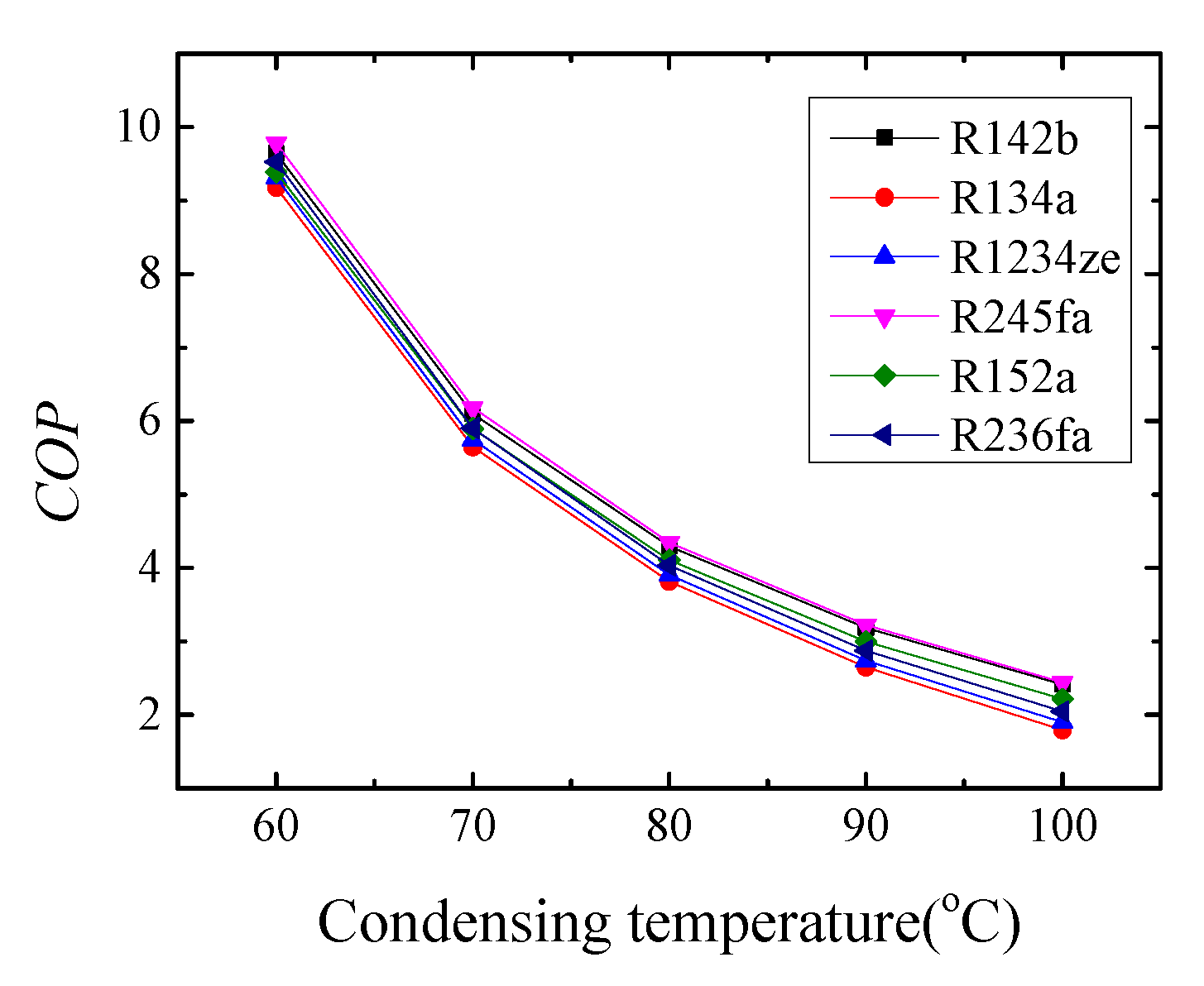

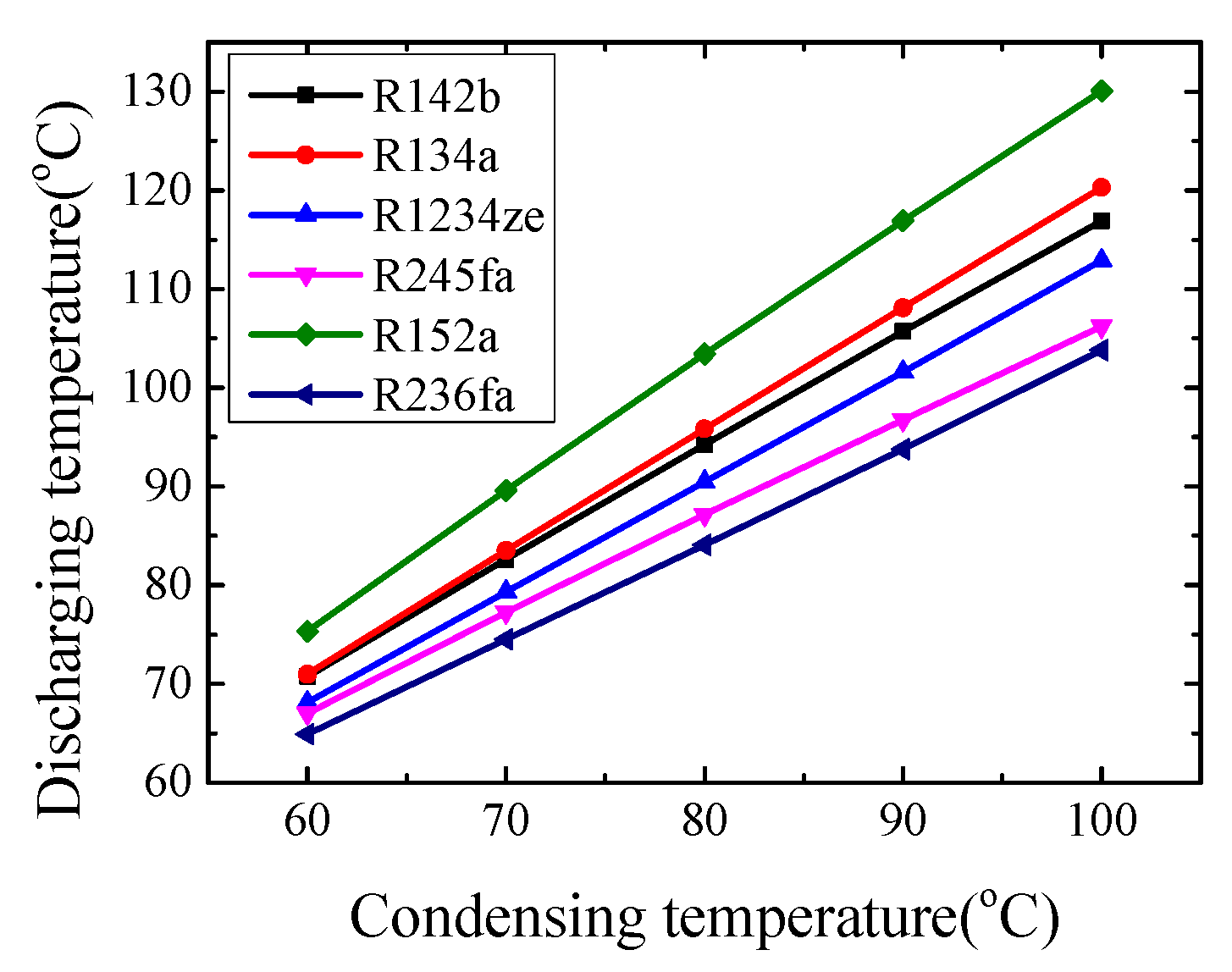

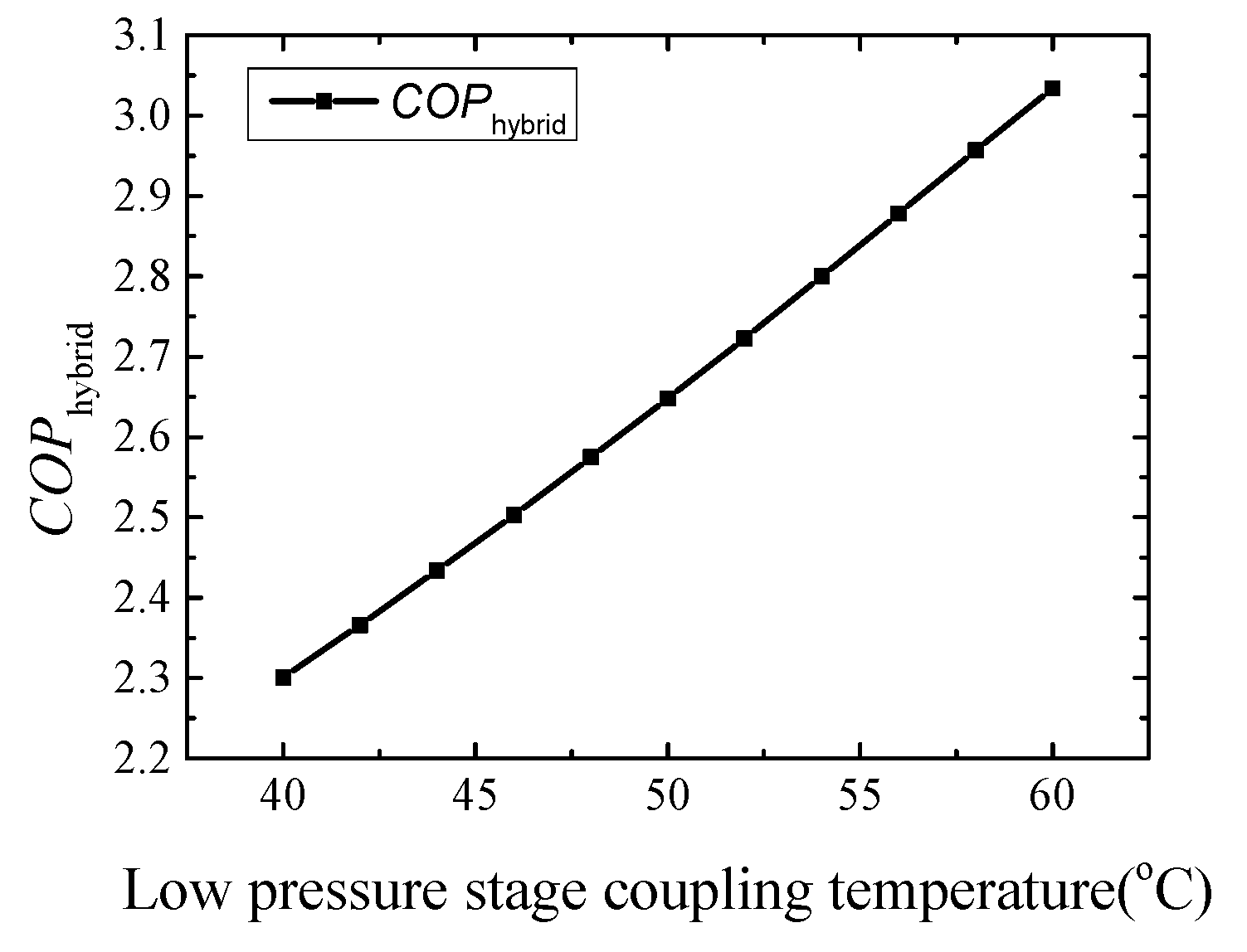

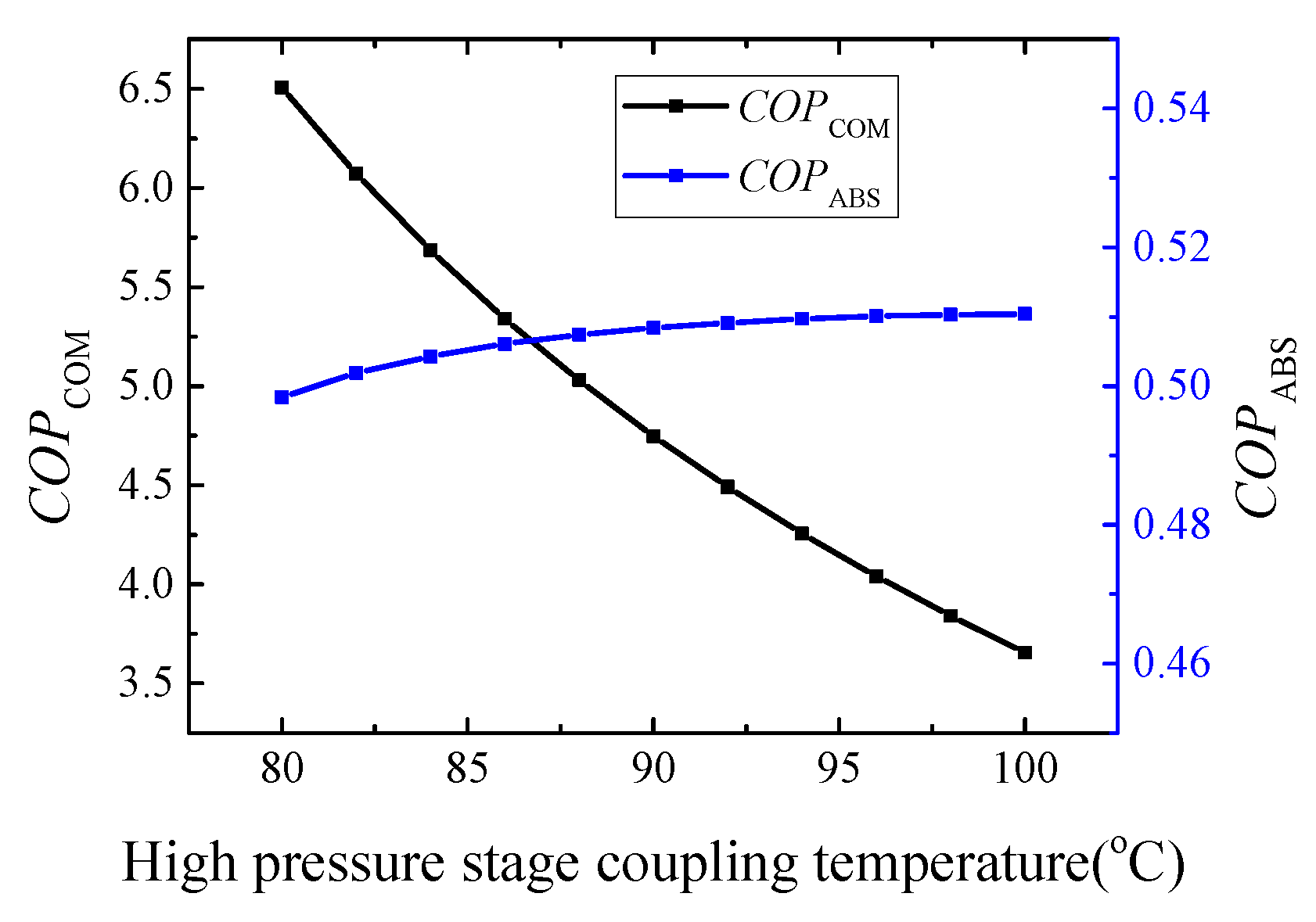
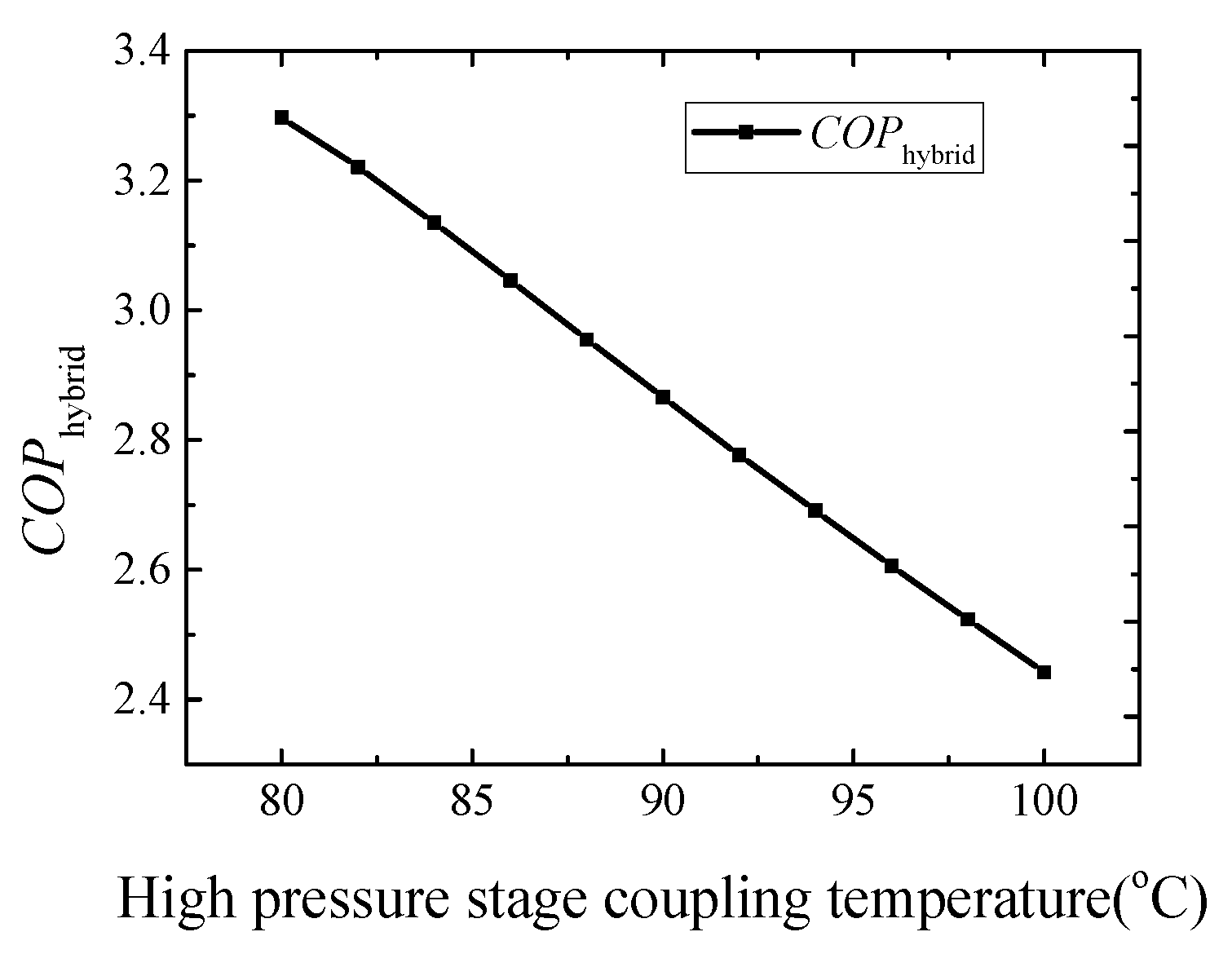
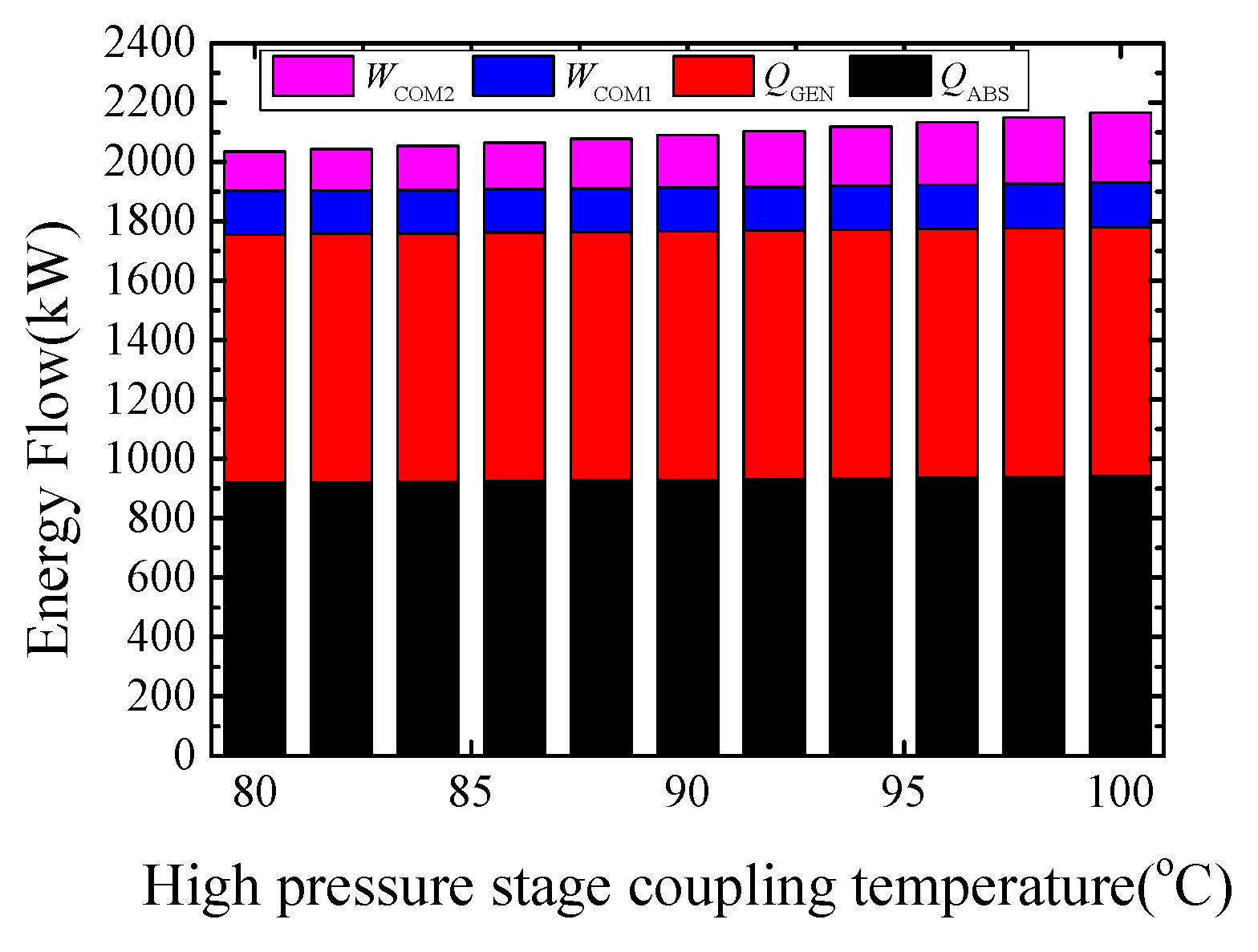
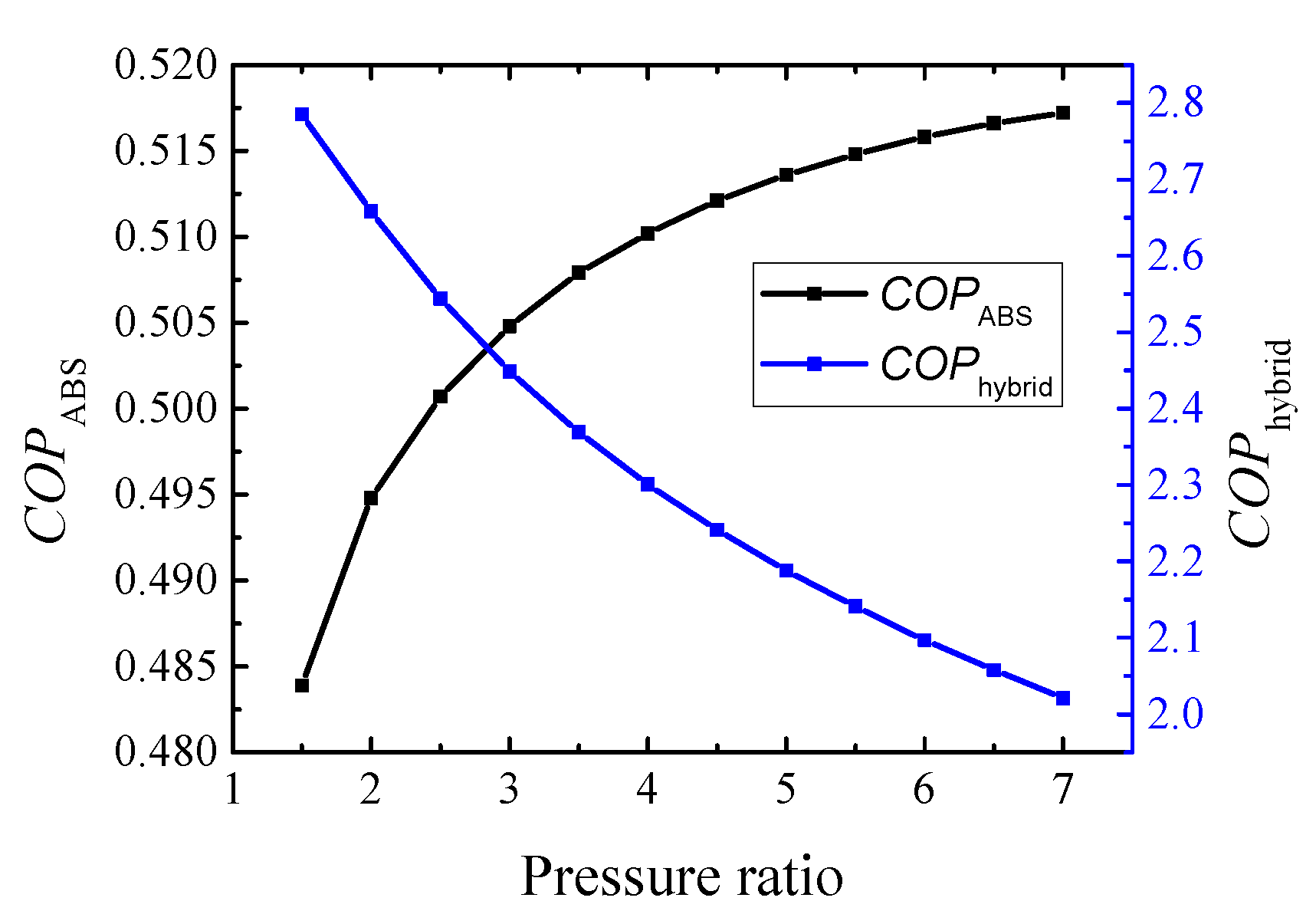
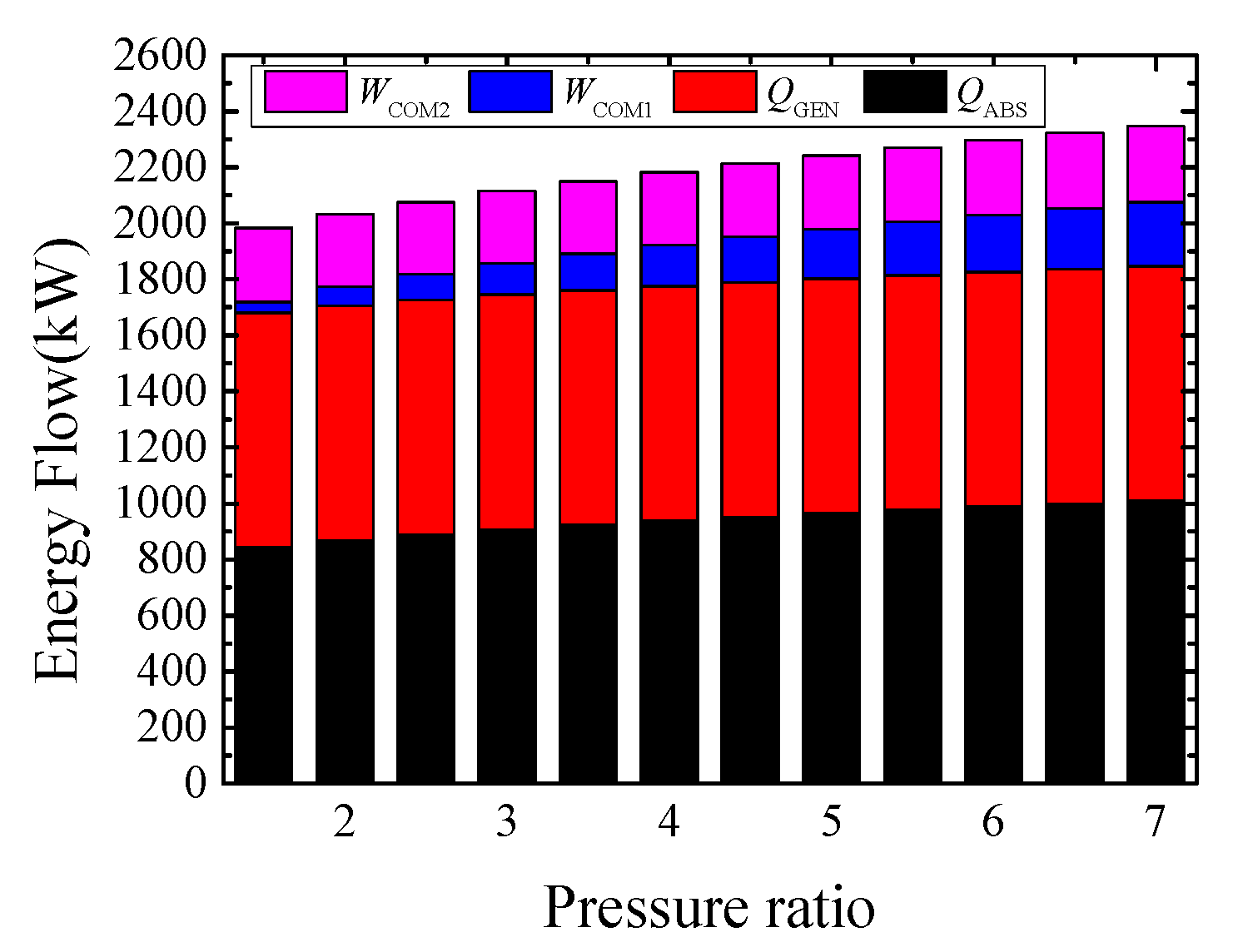

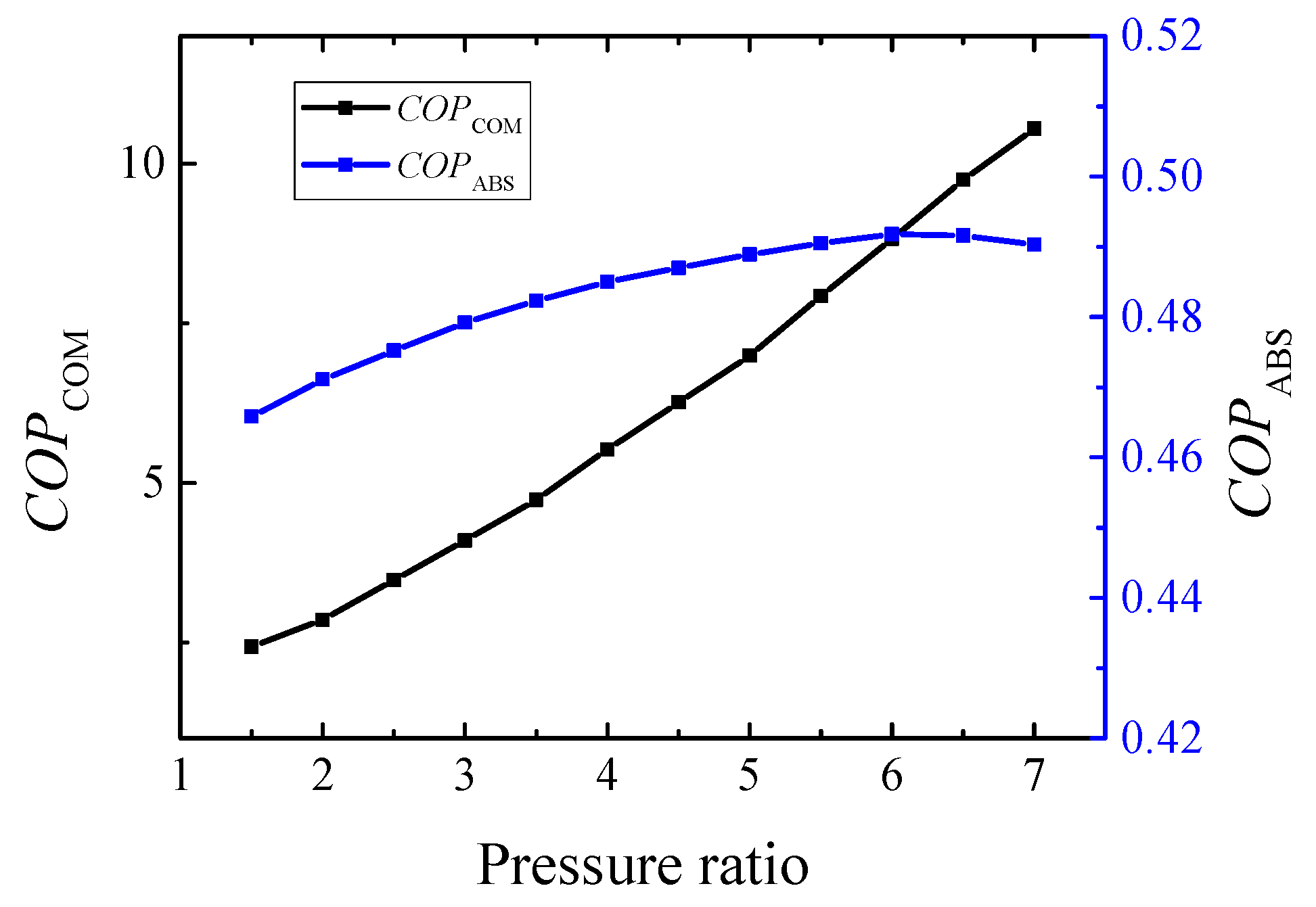
| /°C | /°C | COPref | COP | /% |
|---|---|---|---|---|
| 70.5 | 105 | 0.4804 | 0.4914 | 2.29 |
| 70.5 | 107 | 0.4798 | 0.4895 | 2.02 |
| 70.5 | 109 | 0.4791 | 0.4867 | 1.59 |
| /°C | /°C | COPref | COP | /% |
|---|---|---|---|---|
| 0 | 63 | 2.9 | 2.969 | 2.38 |
| 13 | 70 | 3.3 | 3.268 | 0.97 |
| 26 | 78 | 3.7 | 3.52 | 4.86 |
| Parameter | Value | Parameter | Value |
|---|---|---|---|
| t0 in absorption cycle/°C | 71 | /kW | 837.4 |
| tk in absorption cycle/°C | 57 | /kW | 964.8 |
| te in compression cycle/°C | 55 | /kW | 901.6 |
| tc in compression cycle/°C | 73 | /kW | 861 |
| dr/% | 70.58 | WCOM1/kW | 210.1 |
| da/% | 67.56 | WCOM2/kW | 86.89 |
| ODP | GWP | |
|---|---|---|
| R142b | 0.057 | 1980 |
| R134a | 0 | 1300 |
| R1234ze | 0 | <1 |
| R245fa | 0 | 858 |
| R152a | 0 | 138 |
| R236fa | 0 | 8060 |
| Generator | Absorber | Condenser1-Evaporator2 | Evaporator1-Condenser2 | Compressor1 | Compressor2 | |
|---|---|---|---|---|---|---|
| ηex | 0.808 | 0.872 | 0.943 | 0.978 | 0.817 | 0.877 |
Publisher’s Note: MDPI stays neutral with regard to jurisdictional claims in published maps and institutional affiliations. |
© 2022 by the authors. Licensee MDPI, Basel, Switzerland. This article is an open access article distributed under the terms and conditions of the Creative Commons Attribution (CC BY) license (https://creativecommons.org/licenses/by/4.0/).
Share and Cite
Sun, J.; Wang, Y.; Wu, K.; Ge, Z.; Yang, Y. Analysis of a New Super High Temperature Hybrid Absorption-Compression Heat Pump Cycle. Energies 2022, 15, 7515. https://doi.org/10.3390/en15207515
Sun J, Wang Y, Wu K, Ge Z, Yang Y. Analysis of a New Super High Temperature Hybrid Absorption-Compression Heat Pump Cycle. Energies. 2022; 15(20):7515. https://doi.org/10.3390/en15207515
Chicago/Turabian StyleSun, Jian, Yinwu Wang, Kexin Wu, Zhihua Ge, and Yongping Yang. 2022. "Analysis of a New Super High Temperature Hybrid Absorption-Compression Heat Pump Cycle" Energies 15, no. 20: 7515. https://doi.org/10.3390/en15207515
APA StyleSun, J., Wang, Y., Wu, K., Ge, Z., & Yang, Y. (2022). Analysis of a New Super High Temperature Hybrid Absorption-Compression Heat Pump Cycle. Energies, 15(20), 7515. https://doi.org/10.3390/en15207515






